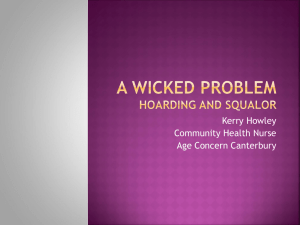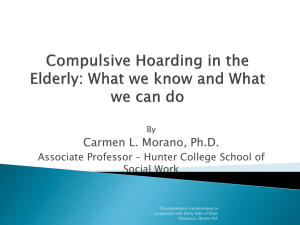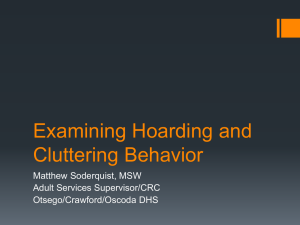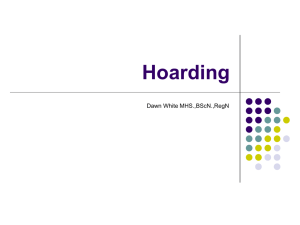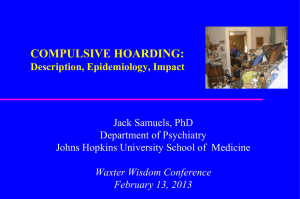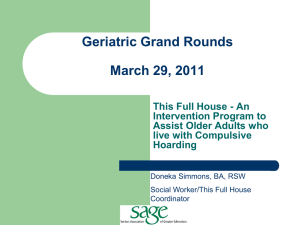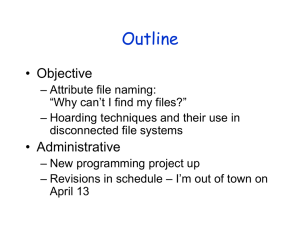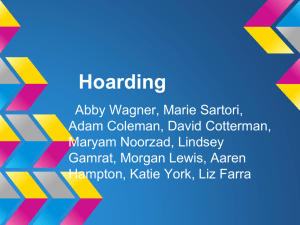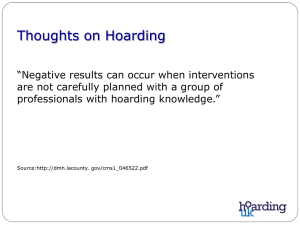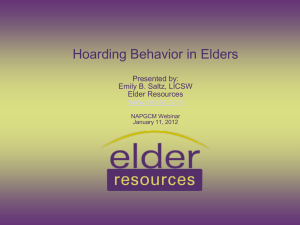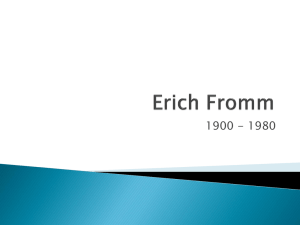Psychoeducation for Clients, Families, and Other Professionals
advertisement
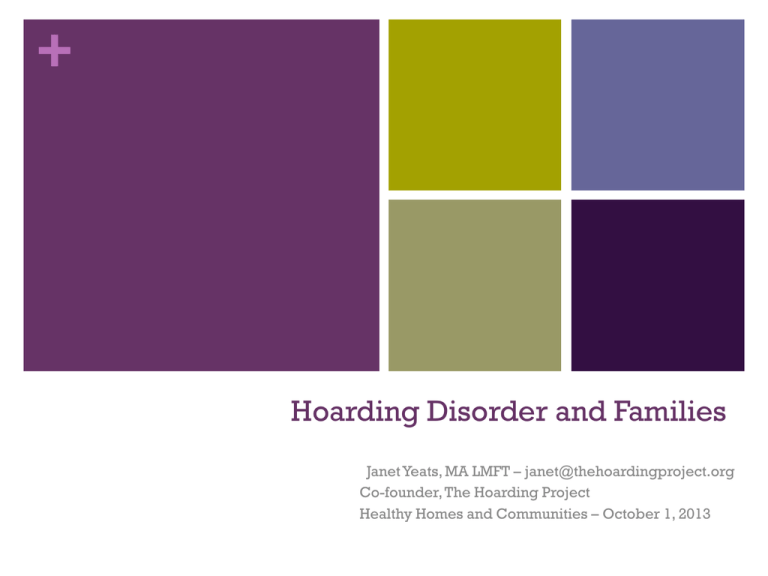
+ Hoarding Disorder and Families Janet Yeats, MA LMFT – janet@thehoardingproject.org Co-founder, The Hoarding Project Healthy Homes and Communities – October 1, 2013 + FAQ: What is compulsive hoarding? Quick answer: With the DSM5 hoarding disorder is a diagnosis, the common definition has 4 parts: 1. Excessive acquisition of stuff 2. Difficulty discarding possessions 3. Living spaces that can’t be used for their intended purposes because of clutter 4. Causing significant distress or impairment + FAQ: What’s the difference between clutter, collecting, and hoarding? Quick Answer: Clutter: possessions are disorganized and may be accumulated around living areas No major difficulty with excessive acquisition AND no major difficulty discarding items Can carry on normal activities in home Collecting: new possessions = part of larger set of items Display does not impede active living areas in home Hoarding: possessions become unorganized piles of clutter Prevent rooms from being used for normal activities Motivation to display items: lost + FAQ’s: How many people hoard? Quick answer: More than you think but we’re really not sure yet! • Estimates range greatly- up to 15 million in the U.S. • Studies haven’t been big enough to give accurate estimates yet Prevalence 2-5% of the population (Iervolino et al., 2009; Samuels et al., 2008) On the high end, That means that over 342 million people on the planet meet criteria for moderate to severe compulsive hoarding behavior. That’s approximately 15.7 million people in the United States. + FAQ’s: Are some people more likely to hoard than others? Quick answer: Research shows that Men hoard more than women Older people hoard more than younger people People with lower income (Samuels, et al. 2008) hoard more than people with higher income + FAQ: What causes hoarding? Quick answer: lots of things can contribute to hoardinglike biological, psychological, and social factors. Family Communities Social The BIOPSYCHOSOCIAL Model of Compulsive Hoarding states that: Compulsive hoarding behavior arises from a variety of external and internal variables that are biological, psychological, and social in nature. Biological Psychological Cultures Environment + FAQ’s: What are the Biological Factors that contribute to hoarding? Family history/genetic link Brain functioning differences Occipital and frontal lobes (Saxena et al., 2004). These are the parts of the brain that are responsible for visual things and executive functioning (see below) Information-processing (cognitive) deficits (Grisham, Brown, Savage, Steketee, & Barlow, 2007; Grisham, Norberg, Williams, Certoma, & Kadib, 2010; Hartl, Duffany, Allen, Steketee, & Frost, 2005; Hartl et al., 2004; Lawrence et al., 2006; Tolin & Villavicencio, 2010; Tolin, Villavicencio, Umbach, & Kurtz, 2010; Wincze, Steketee, & Frost, 2007) Attention Memory Categorization Complex thinking Decision-making + FAQ’s: What are the Psychological Factors that contribute to hoarding? Mental health/emotional distress Unresolved trauma and loss People who hoard have specific beliefs about and attachment to their possessions (Frost & Hartl, 1996) Feelings toward object Memory-related concerns Desire for control Responsibility and waste Aesthetics Hoarding behaviors can be reinforced over time (Frost & Hartl, 1996) Acquiring things makes us feel good, so we want to do more of it Getting rid of things makes us anxious, so we want to do less of it Triggering Event Conditioned Response Emotional Response Behavioral Reinforcer (+/-) + FAQ’s: What are the Social Factors that contribute to hoarding? Interpersonal relationships Social support The more support experienced from family, the less hoarding (Sampson & Harris) Major life events/transitions The better family connections (in past and present), the less hoarding (Sampson & Harris) Unresolved trauma and loss contributes to hoarding (Sampson & Harris) Social stigma “Hoarding is weird” Stigma can contribute to depression, anxiety, etc. Culture Western, consumer cultures = hoarding is present Not sure about other, non-consumer-driven cultures Consider context (e.g. refugee families, etc) + FAQ: Is hoarding really just OCD? Quick answer: Not necessarily Only about 30-40% of people who hoard actually show other symptoms of OCD It’s likely it’s own standalone disorder and they’re proposing to add a diagnosis in the next version of the Diagnostic and Statistical Manual for Mental Disorders (DSM) It’s also associated with lots of other mental health issues: Depression- <53% Anxiety- <24% ADHD- <20% Impulsivity Personality Disorders- <29% Organic Brain Illness- <31% + FAQ: Hoarding must be some sort of coping mechanism, right? Quick answer: It depends. Trauma has been related to hoarding in the research Traumatic life events (Cromer, Schmidt, & Murphy, 2007; Hartl, Duggany, Allen, Steketee, and Frost, 2005) 76%: endorsed a history of a traumatic life event (Breslau et al., 1998) 55%: stressful life event around onset of hoarding (Grisham, et al., 2006) Relational traumas But it can also be considered a reinforced behavior that occurs over time because of difficulties with: 1. History/vulnerabilities 2. Information-processing deficits 3. Beliefs about possessions 4. Emotions 5. Reinforcement Cognitive Behavioral Model of Compulsive Hoarding (Frost & Hartl, 1995) + FAQ: Does therapy work come before, during, or after work on the hoarding problems? Quick answer: It depends. Oftentimes, we can do them simultaneously when safety and coping skills are in place. Rule of thumb: 1. Safety first. 2. Skills second. Emotional regulation (self-soothing) Self-awareness/mindfulness Organization, categorization, etc 3. Everything else can Grief, loss, and trauma Hoarding work: acquisition/discarding follow. + FAQ: Can’t I just clean out my loved one’s home? Quick answer: Not if you can avoid it. It can do more harm than good. Can be traumatizing Even threats can be unhelpful Can ruin relationships and trust “In all three instances of going in and cleaning these places up, within weeks of relocating the individual back into a clean environment, the individual passed away…it was such a dramatic change for them because we didn’t realize the impact of the sociological change.” (Brace, 2007) It’s not sustainable 1 year 2 year 3 year 4 year 5 year 6 year 7 year 8 year 9 year 10 year Cleanout 1 month 3 month 6 month Higher relapse rate among forced clean out You’ll just have to do it again later Sometimes it’s necessary though Involve the homeowner as much as possible for lasting change + FAQ: What’s up with animal hoarding? Is it the same thing as object hoarding? Similarities: answer: There are some similarities between the two, but they differ in several ways. Quick Research on animal hoarding is about 20 years behind object hoarding Acquisition, difficulty discarding, clutter, distress Many people who hoard animals also hoard objects Co-morbidities Differences: Animal hoarding: squalor (100% of homes) Gender and age differences AH: More women; later age Types of objects: Objects: variety Animals: one species Lack of treatment for A.H. MAJOR mental health concerns (a mental health professional must be involved) + FAQ: What resources are available? Quick answer: There are several different resources that are available to people who hoard, their families, and people who work with them. Non-profit agencies: The Hoarding Project (local) International OCD Foundation Mental Health Association of San Francisco Institute of Challenging Disorganization Children of Hoarders Support Groups The Hoarding Project (local) Children of Hoarders Bay Area Resources Clutterers Anonymous
